Soft-point bullet
A soft-point bullet (SP), also known as a soft-nosed bullet, is a jacketed expanding bullet with a soft metal core enclosed by a stronger metal jacket left open at the forward tip. A soft-point bullet is intended to expand upon striking flesh to cause a wound diameter greater than the bullet diameter. Jacketed soft point bullets are usually abbreviated JSP in the ammunition and reloading industry.
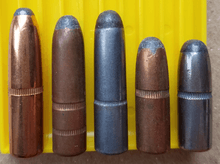
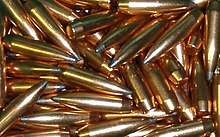
Evolution
Lead-alloy bullets used with gunpowder firearms were unsatisfactory at the bullet velocities available from rifles loaded with nitrocellulose propellants like cordite. By the late 19th century, lead-alloy bullets were being enclosed within a jacket of stronger mild steel or copper alloyed with nickel or zinc to reliably impart stabilizing rotation in rifled barrels. The lead-alloy core was swaged into a cup of the stronger metal covering the front and sides of the core, but leaving some of the core exposed on the base of the bullet. The bullet jacket may be described as a metal envelope, steel envelope, or hard envelope; and the jacketed bullet may be described as metal-covered, metal-patched, or metal-cased.[1]
These jacketed bullets fired by modern rifle cartridges were typically of smaller diameter than lead-alloy bullets of earlier gunpowder cartridges, and the stronger jacket made them less likely to be deformed during handling or loading. The tendency of jacketed bullets to pass through an animal with minimum deformation or expansion was perceived as a more humane way to incapacitate military soldiers, but was considered less effective for killing hunted animals. Reversing the direction of jacket placement leaves the exposed lead-alloy core on the forward tip of the bullet creating a soft-point bullet.[1]
Expansion
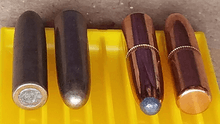
Soft-point bullets expose the soft lead-alloy core on the forward part of the bullet most likely to be deformed when striking a target. The sides of the bullet remain covered by the jacket to reliably impart stabilizing rotation from rifling. Expansion of a soft-point bullet depends upon the hardness of the lead-alloy core, the strength of the surrounding metal jacket, and the energy available from the decrease in bullet velocity as the bullet encounters target resistance. A core of pure lead is softer than a core of lead alloyed with metals like antimony and tin. Some jacket alloys have greater tensile strength than others; and, for any given alloy and annealing process, a thicker jacket will be stronger than a thinner jacket. Energy available to expand the bullet is proportional to the square of the velocity at which the bullet strikes the target. If the bullet passes through the target, the energy represented by the square of the velocity of the departing bullet has no effect on the target. Soft point bullets may not expand if they strike a target at low velocity, or if the target does not slow the bullet enough to deform the exposed point or rupture the surrounding jacket.[1]
Varmint rifle bullets with thin jackets are intended to expand rapidly and disintegrate upon encountering minimum resistance. Bullets intended for big-game hunting are designed to increase their forward diameter while remaining intact to penetrate deeply enough to damage internal organs likely to cause rapid death. Big-game bullets sometimes have a specialized jacket including a center baffle between a forward core intended to expand and another core intended to remain intact. Alternative designs include a jacket with an internally thicker belt around the central part of the bullet intended to resist expansion while the thinner forward part of the bullet jacket ruptures. Some bullets have a core formed from a soft alloy in the forward part of the bullet bonded to a harder alloy core in the rear of the bullet. Others have a jacket which is thicker near the base of the bullet and tapers to a thin fringe adjacent to the soft point.[1]
Hollow-point bullets
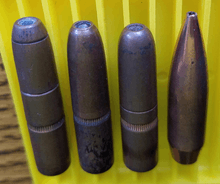
Soft-point bullets are similar to jacketed hollow-point bullets, because both have a jacket open on the forward tip. The soft core is exposed forward of the jacket on soft-point bullets, while the jacket may extend forward of the core on hollow-point bullets emphasizing aerodynamic improvement rather than expansion. Bullets with a large amount of core exposed forward of the jacket might have a hollow point within that core; and some hollow-point bullets have no jackets.[1]
Flat-point bullets
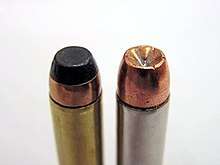
Jacketed flat point (JFP) may describe either soft-point or full metal jacket bullets with a flat, rather than a rounded front. Until recently, flat-point bullets were required in centerfire rifles with tubular magazines, such as the Winchester rifle, where the rounds are stored front-to-back. Use of metal-pointed bullets in these rifles can be highly dangerous, as the point of the bullet will rest against the primer of the round in front of it and can cause a detonation under the force of recoil. Since late 2005,[2] newer bullet designs with polymer tips offering improved ballistics have become available for safe use in tubular magazine rifles.[3]
References
- Sharpe, Philip B. (1953). Complete Guide to Handloading (3rd ed.). New York: Funk & Wagnalls. pp. 112–126.
- "Hornady LEVERevolution Ammunition". Chuckhawks.com. Retrieved 2015-09-05.
- "Hornady Manufacturing Company :: Ammunition :: Rifle :: Choose by Product Line :: LEVERevolution®". Hornady.com. Retrieved 2015-09-05.